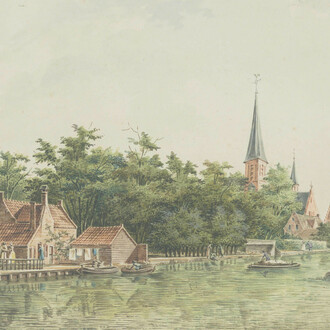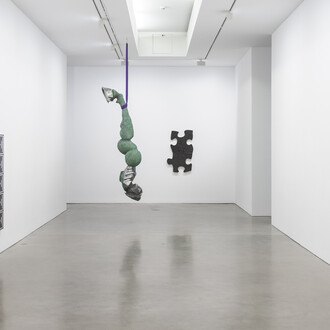Hreinn Friðfinnsson presents, in his seventh exhibition at the gallery, works from the last three decades of his artistic practice as well as a new, extensive installation.
The artist frequently works with the most simple everyday materials, altering them with precise minimal interventions, such as in his iconic work Sanctuary (1992–2014). The work consists of a cardboard box installed as an object on the wall at eye-level. Its top flaps are slightly opened to reveal an intense green colour shimmering on the inside of the cross-shaped object, suggesting an unfathomable, seemingly sacred space. In this slightly altered readymade, Friðfinnsson unfolds the conceptual and poetic potential of seemingly banal things that already exist. His lyrical conceptualism is close to the work of Marcel Duchamp as well as Arte Povera and Land Art. Characteristic of his work— which focuses on the most ephemeral, fleeting qualities of the world around him—is, however, a subtle sense of humour and the acknowledgement of a supernatural dimension. Narrative as well as a specific perception of landscape are deeply ingrained across his body of work. Landscape is conceived of as the result of a symbiosis of nature and psyche, rooted in the memories and sagas of his native Iceland.
In his new installation Hulduklettur (“black” or “concealing rock”—from the Icelandic huldur, meaning “dark” or “concealed,” and klettur, meaning “rock”) the artist presents a rugged landscape of cardboard boxes, amongst which can be found a variety of artefacts like ammonites, crystals, an anatomical model of an ear, images of a Nautilus and galaxies. Together, they form a complex picture of natural phenomena, the unifying element being the Fibonacci spriral. The spiral, which is considered to be the epitome of Fibonacci’s mathematical system, is understood as a kind of growth pattern and fundamental principle of nature. This symbiotic relationship between mathematics, philosophy, and aesthetics is executed as well in the work Principle and Temptation (1991), whose individual squares are proportioned according to the golden section, a calculation likewise derived from the Fibonacci sequence.
Illustration (2014) is comprised of two photographs and a Mirage instrument to illustrate a three-dimensional reflection and literally illustrates Friðfinnson's legendary House project: In 1974 he built an house in a remote area of Iceland, turning it inside-out. This first house was followed by several manifestations, each of which gradually dematerialized with every new version. The fourth manifestation, which has been exhibited at Skulptur Projekte Münster this year, is an outline of the original house’s frame, made from highly reflective steel—a kind of echo of the first house. The spherical Mirage object exhibited in the gallery creates a hologram of the house’s outline that seems to float above a volcanic landscape. The hologram is the dematerialized, mirrored version— thereby becoming the memory of all previous manifestations of the house, a container of all possibilities, reflecting the genesis of the first house.
Study In Black III (2010) echoes this idea of an imagined world: in this case, using the mirror as a paradigm of art. The installation consists of a rectangular black mirror, a historic Claude Mirror, which served as an optical aid to artists in the 18th century; and a photograph of such a mirror. The work takes up the traditional mode of looking at landscape and framing the world, while at the same time throwing it back at the viewer and the exhibition space, which appears as a landscape itself, reflected in the black mirror—thereby being the ultimate monochrome image. Study In Black III is thus also a reflection on how we actually construct an idea of "landscape," and the desires lying at the core. The video Untitled (Books) (2005–09) shows books scattered across the Icelandic tundra, the wind turning their pages, as if they have always been part of the landscape.
Born in 1943 in Baer Dölum, Iceland, Hreinn Friðfinnsson has been living in Amsterdam since 1971. He was co-founder of the Icelandic avant-garde artists’ collective SÚM and has exhibited internationally since the 1970s. He recently had solo exhibitions at Kunstverein Amsterdam (2015); The Living Art Museum, Reykjavík (2014); Bergen Museum and Malmö Konsthall (both 2008); Reykjavik Art Museum and Serpentine Gallery, London (both 2007); Domaine de Kerguehennec, Centre d’Art Contemporain, Bignan, and Kyoto Art Center (both 2002). He participated in Skulptur Projekte Münster 2017. In 2012 he participated in the 30th Sao Paulo Biennial and in 1993 represented Iceland at the 45th Venice Biennale. Recent significant participations include group exhibitions at Garage Center for Contemporary Culture / GCCC, Moscow, and Mudam Luxemburg (both 2014) MOCA Los Angeles and Haus der Kunst, Munich (both 2012), Reykjavik Arts Festival (2005); Jeu de Paume, Paris (2004). In 2000 the artist was the recipient of the prestigious Ars Fennica Prize. Hreinn Friðfinnsson has been exhibiting with Galerie Nordenhake since 1989.
















